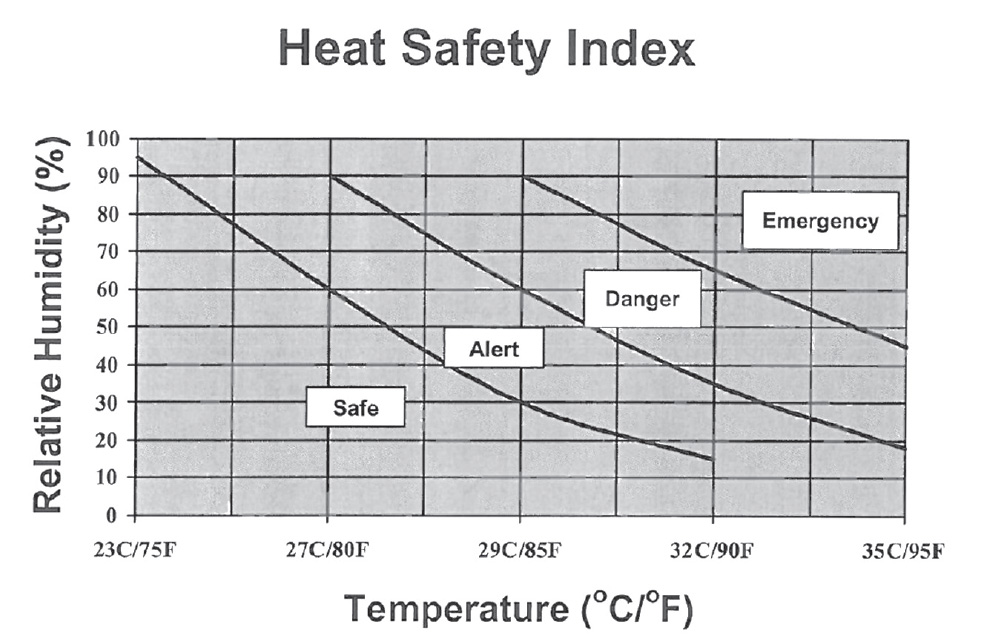By Michelle Jacobs
REGISTERED KINESIOLOGIST
Summer is in full swing and so is the heat. As we spend as much time soaking in this beautiful weather there are a few safety considerations, especially as it relates to being physically active in the heat. Exercising in the heat can increase our risk of having a heat-related illness which can start as a mild symptom but quickly become life threatening.
Knowing the signs and symptoms can help ensure you get the proper treatment.
The mildest symptom are heat cramps, sometimes called exercise-associated muscle cramps. This is when you experience painful muscle contractions while exercising. The affected muscles may feel firm to the touch, and you may feel muscle pain or spasms. At this point your body temperature may by normal. Treatment involves stretching the muscle and starting to rehydrate with water.
Heat syncope is a feeling of light-headedness or fainting caused by high temperatures. This often occurs after standing for a long period of time; or standing quickly after sitting for a long period of time. When the feeling of light-headedness or fainting occurs immediately after exercising it is referred to as exercise-associated collapse. The most common time for this to happen is if you stop running and stand after a race or long run.
Treatment for these conditions is to drink fluids such as water or a sports drink to rehydrate. Move to a cooler place, and place cool, wet towels or ice packs on your neck, forehead and under your arms to help lower your body temperature. If possible, have someone stay with you who can help monitor your condition.
The most severe conditions are heat exhaustion followed by heatstroke. Heat exhaustion occurs when your body temperature rises as high as 104 F (40C), and you may experience symptoms such as nausea, vomiting, weakness, headache, fainting, sweating and cold, clammy skin. If left untreated, heat exhaustion can lead to heatstroke.
Heatstroke happens when your body temperature is greater than 104F (40 C) and is a life-threatening emergency condition. Your skin may be dry from lack of sweat, or it may be moist. The simple treatments may no longer be enough, and it is important to get medical treatment.
I am not saying avoid spending any time exercising outdoors. There are some simple steps you can take to make sure your time outside is safe. First check the Heat Safety Index. When the temperature and humidity are in the SAFE zone, go ahead and exercise as normal outdoors. If the temperature and humidity fall into the ALERT zone this is when you want to SLOW your exercise pace outdoors. However, when the temperature and humidity fall in the DANGER or EMERGENCY zone it is not safe to exercise outdoors and changing to an indoor activity is recommended.
Other simple tips to enjoy the outdoors are to aim to exercise in the morning or the evening when the temperature is typically cooler.
Dress for the weather by wearing lightweight, light-coloured, and loose-fitting clothing. If you are on medications know the side effects as heat can impact how your body responds to them.
Lastly drink plenty of fluids to stay hydrated. Men are recommended that they get 15.5 cups (3.7 liters) of fluids a day and women are recommended to get 11.5 cups (2.7 liters) of fluids a day.
Following these tips and knowing the signs and symptoms of heat related illnesses will help you to enjoy a great summer filled with outdoors activities.
Stay active and safe!
For more information about any of the free services offered by your local Family Health Team ask your doctor or nurse practitioner during your next visit, visit the website www.afhto.ca or google ‘family health team locations’.
Michelle Jacobs is a Registered Kinesiologist, CSEP-CEP, with the Kincardine Family Health Team




